Medicare Monday: What you need to know about the latest Medicare Trustees report
Takeaways from the 2017 Medicare Trustees report.

Medicare Monday: What you need to know about the latest Medicare Trustees report.
Takeaways from the 2017 Medicare Trustees report.

Medicare Monday: What you need to know about the latest Medicare Trustees report.

Last week, the Trustees of the Social Security and Medicare trust funds released its annual report on the current and projected financial status of Medicare. Here are a few important takeaways in the 2017 report:
Members of Congress on both sides of the aisle have called for repeal of IPAB, and this year there is a unique opportunity to use a special, fast track procedure (the Joint Resolution to Discontinue the Board). If the special Joint Resolution is enacted by August 15, 2017, IPAB will be repealed. This week, the House Energy and Commerce Subcommittee on Health will discuss ways to improve Medicare, and repealing IPAB is one of the topics set to be discussed. Learn more about IPAB and what it could mean for Medicare here.
Learn more about Part D at PhRMA.org/PartD and Part B at PhRMA.org/PartB.